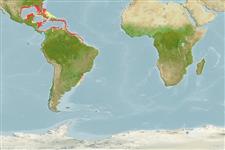Elasmobranchii (tubarões e raias) (sharks and rays) >
Carcharhiniformes (Ground sharks) >
Triakidae (Houndsharks) > Triakinae
Etymology: Mustelus: Latin for weasel, an ancient name for sharks, possibly referring to the pointed snouts, swift movements and/or rapacious feeding behavior of smaller predatory sharks [strictly not tautonymous with Squalus mustelus Linnaeus 1758 since type was designated by the ICZN] (See ETYFish); norrisi: In honor of American zoologist Harry Waldo Norris (1862-1946), Grinnell College (Iowa), who studied the cranial nerves of the Spiny Dogfish Squalus acanthias (See ETYFish).
Eponymy: Dr Harry Waldo Norris (1862–1946) was a zoologist and anatomist who was Professor of Biology and Zoology and Curator of the Museum at Grinnell College, Iowa (1891–1931) and was Research Professor of Zoology (1931–1941), retiring as Emeritus [...] (Ref. 128868), visit book page.
Environment: milieu / climate zone / intervalo de profundidade / distribution range
Ecologia
marinhas demersal; intervalo de profundidade 1 - 100 m (Ref. 55584), usually 3 - 40 m (Ref. 55311). Subtropical; 32°N - 36°S, 99°W - 47°W (Ref. 55311)
Western Atlantic: Florida, USA and the northern Gulf of Mexico to Venezuela; also southern Brazil.
Tamanho / Peso / Idade
Maturidade: Lm ? range ? - ? cm
Max length : 110 cm TL macho/indeterminado; (Ref. 40637); common length : 80.0 cm TL macho/indeterminado; (Ref. 5217); peso máx. Publicado: 13.8 kg (Ref. 40637)
Found on the continental shelves, on muddy or sandy bottoms to about 80 m depth. Feeds on crabs and shrimps, and also bony fishes. Viviparous (with a yolk-sac placenta), with 7 to 14 young in a litter. Size at birth 30 cm.
Life cycle and mating behavior
Maturidade | Reprodução | Desova | Ovos | Fecundidade | Larvas
Viviparous (with a yolk-sac placenta) (Ref. 244). Distinct pairing with embrace (Ref. 205).
Compagno, L.J.V., 1984. FAO Species Catalogue. Vol. 4. Sharks of the world. An annotated and illustrated catalogue of shark species known to date. Part 2 - Carcharhiniformes. FAO Fish. Synop. 125(4/2):251-655. Rome: FAO. (Ref. 244)
Categoria na Lista Vermelha da IUCN (Ref. 130435: Version 2025-1)
Ameaça para o homem
Harmless
Utilização humana
Pescarias: pouco comercial; peixe desportivo: sim
Ferramentas
Relatórios especiais
Descarregue XML
Fontes da internet
Estimates based on models
Preferred temperature (Ref.
123201): 22.6 - 28, mean 25.7 °C (based on 450 cells).
Phylogenetic diversity index (Ref.
82804): PD
50 = 0.5000 [Uniqueness, from 0.5 = low to 2.0 = high].
Bayesian length-weight: a=0.00170 (0.00097 - 0.00299), b=3.10 (2.95 - 3.25), in cm total length, based on LWR estimates for this species & Genus-body shape (Ref.
93245).
Nível Trófico (Ref.
69278): 3.9 ±0.67 se; based on food items.
Resiliência (Ref.
120179): Muito baixo, tempo mínimo de duplicação da população maior que 14 anos (Fec=7).
Fishing Vulnerability (Ref.
59153): High to very high vulnerability (66 of 100).
🛈
